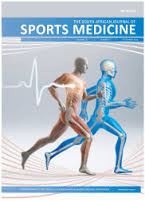The reliability of the scapular posture and scapular dyskinesis tests in rugby union players
DOI:
https://doi.org/10.17159/2078-516X/2021/v33i1a11674Abstract
Background: Impact forces during rugby can contribute to scapula dysfunction and shoulder pain. Reliable assessment of static and dynamic scapula position is paramount in managing athletes with, and those at risk of developing, shoulder pain.
Objectives: To determine the reliability of static scapular posture (SP), clavicular tilt angle (CTA) and the scapular dyskinesis (SD) assessments by expert and student therapists.
Methods: The study design was an inter-rater and intra-rater reliability study in male university level rugby union players. Four sport rehabilitation students and one experienced physiotherapist evaluated the position of the scapular and clavicle of male university-level rugby union players (inter- rater participants: session 1: n=17, session 2: n=12 and session 3: n=16; (intra-rater participants: n = 12). Participants attended 3 testing sessions, each 1 week apart. Scapular orientation and motion were assessed in five planes of movement and using the Scapular Dyskinesis Test (SDT) respectively. The inter- rater analysis included all participants from each session, while in the intra-rater analysis included only the 12 participants who attended all three testing sessions.
Results: Kappa coefficient values and percentage agreement ratings for students compared to the experienced therapist were: SP=poor to fair (-0.01 to 0.33), (27% - 94%); SDT=slight (0.16; 41%); CTA=fair (0.21; 59%). Test-retest (intra-rater) agreement was fair to moderate (0.22 – 0.44; 69% - 95%), slight (0.12; 47%), and fair (0.39; 77%) for the SP, SDT, and CTA, respectively.
Conclusion: Static and dynamic evaluation of the shoulder by students and an experienced therapist has poor to moderate reliability and should not be used to make clinical decisions based on observation alone.
Downloads
Downloads
Published
Issue
Section
License
Copyright (c) 2021 South African Journal of Sports Medicine

This work is licensed under a Creative Commons Attribution 4.0 International License.
The South African Journal of Sports Medicine reserves copyright of the material published. The work is licensed under a Creative Commons Attribution 4.0 (CC BY 4.0) International License. Material submitted for publication in the South African Journal of Sports Medicine is accepted provided it has not been published elsewhere. The South African Journal of Sports Medicine does not hold itself responsible for statements made by the authors.
How to Cite
- Abstract 640
- PDF 429





.png)